New Buddha Hall Rising for Sravasti Abbey
Written by: Venerable Thubten Chonyi

An architect’s rendering of the Buddha Hall, overlaid on a photo of the building site.
Photos by: Courtesy Sravasti Abbey
Sravasti Abbey, a Buddhist monastery in northeast Washington state, is building a long-awaited 17,000-square-foot temple and library.
Buddha Hall will become the center of religious life for the resident monastic community and for thousands of guests far into the future. After a one-year delay due to the pandemic, Buddha Hall construction is expected to begin this summer.
Long time coming
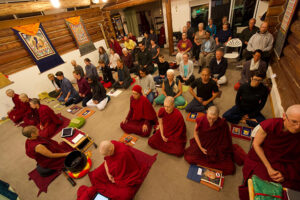
Weekend retreats pre-2020 packed the present Meditation Hall.
The idea of Buddha Hall has been in the mind of Sravasti Abbey founder, Venerable Thubten Chodron, since she started the monastery. What monastery exists without a central structure for study, practice, meditation and teachings?
But everything starts small. The original abbey property, purchased in 2003, came with a large barn, two-story house, and an adjacent two-car garage. Transforming the log-cabin-style garage into a meditation hall became the abbey’s first construction project.
Since then the meditation hall has supported more than 300 meditation retreats and dharma courses, more than a dozen monastic ordinations, and housed regular monastic rituals. In addition monastic residents use it for twice-daily practices, frequent pujas, and annual winter retreats.
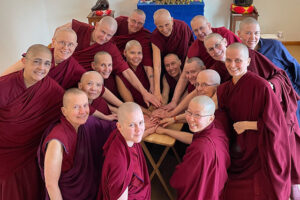
The Sravasti Abbey community unanimously agree to “go for it” in 2021.
The current meditation hall comfortably seats about 40 people, but has been pushed to hold far more.
“Everyone really loves our little meditation hall,” Venerable Chodron said, “but we always knew its service would be temporary.”
The abbey’s original master plan included a temple, but more pressing construction needs came first: housing for nuns; kitchen, dining, and guest facilities; and a cottage for the abbess.
Sravasti Abbey is one of the first training monasteries for English-speaking monastics in Tibetan tradition in the United States. Its 16 nuns and one monk are dedicated to learning and practicing Buddha’s teachings, and sharing them with others.
American born, Venerable Thubten Chodron is a well-known Buddhist author and teacher, who also has collaborated with His Holiness the Dalai Lama on a series of books.
Need for space
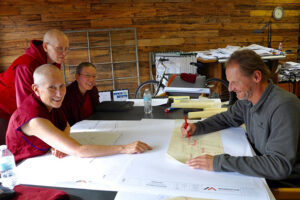
Part of the abbey building team meets with the architect. Left to right Venerable Chodron, Venerable Tarpa, Venerable Damcho, and Tim Wilson.
The abbey has grown steadily, and increasing demand for seating is driving the Buddha Hall project. Before Covid-19 shut the doors for 17 months, more than 1,000 people visited each year. Some residential retreats drew 50 to 60 people, while attendance for one-day events sometimes reached 100.
Visitors have included Buddhists and curious non-Buddhists from six continents. In addition many local people have visited from the mountainous rural area surrounding the monastery, which is near Newport, Washington, north of the eastern Washington city of Spokane.
Gradually the growing number of participants forced abbey residents to move some programs into the large dining room in Chenrezig Hall, completed in 2014.

Architect’s model of the altar in the Buddha Hall main hall.
While this made more space for meditation and teachings, it presented new problems. Where would people sit for meals? Abbey residents and guests gamely set up and took down tables many times a day to accommodate the room’s changing functions. Clearly, this was not ideal.
By 2018 the situation was untenable, and Venerable Chodron and the seasoned monastic building team began to meet with architect Tim Wilson, designer of two previous abbey projects. The team wanted a Buddha Hall that could accommodate the community’s growth and support Buddhist learning for hundreds of years.
A beautiful building
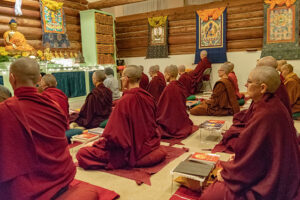
The Living Vinaya in the West nuns’ conference practice session filled the present Meditation Hall.
The two-story Buddha Hall is designed for the future. Its three meditation spaces on the main floor offer combined capacity for 200 people. A large library, media room, and classrooms are on the lower floor. The plans include a small apartment for visiting teachers, and a wrap-around covered deck that will allow chanting and circumambulating in all weather conditions.
The altar in the largest space will feature three large custom-designed statues: a 10-foot Shakyamuni Buddha; a slightly smaller statuesof Venerable Ananda, the Buddha’s attendant; and a statue of Venerable Mahaprajapati Gotami, the Buddha’s stepmother and founder of the nuns’ order. Seating capacity in the largest facility is 100.
Two side areas will each seat 50 people. The Tara Chapel will be for more intimate teachings, meditations and ceremonies. The chapel will feature a central Tara statue, surrounded by 21 smaller Taras gracing the surrounding altar.
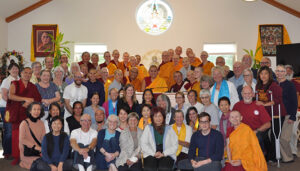
Kyabje Ling Rinpoche’s visit drew a huge crowd, requiring him to teach in the dining room.
The Posadha Room will house monastic ceremonies, during which the abbey community functions as a fully ordained nuns’ (bhikshuni) sangha. This room will feature a Shakyamuni Buddha statue and smaller statues of the 16 arhats, the Buddha’s leading realized disciples.
In addition the Buddha Hall will include the Dedication Room, where people can post names of anyone requesting prayers. Mourners will be able to use the private space to peacefully pray and practice.
Sculptors Peter and Denise Griffin are already working on statues for the main hall, at their studio in France. They have created Buddha images for decades, including several for Lama Zopa Rinpoche’s international Foundation for the Preservation of the Mahayana Tradition (FPMT) centers. An abbey team is also working with Threshold Acoustics to ensure that all the rooms have impeccable sound quality, and are properly wired for streaming.
The Buddha Hall will be built from Faswall, environmentally friendly insulated building blocks made of recycled wood chips and cement. Faswall makes a sturdy structure that is fire and pest-resistant. It has been used for two previous abbey buildings.
“We expect Sravasti Abbey monastics to practice and share the Buddha’s teachings for a very long time,” Venerable Chodron said, “so these buildings need to last.”
Pause for covid
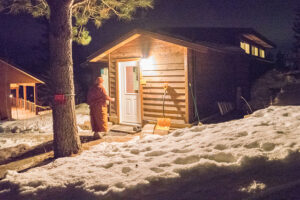
In all seasons the Meditation Hall has served well for many years.
The Buddha Hall project has been stalled more than a year due to the global pandemic. In early 2020 Sravasti Abbey had a building design and a commercial contractor ready to build, and the Sravasti team was about to launch a challenge gift campaign to fund the multi-million dollar project.
But then Washington state went into a statewide lockdown to slow the coronavirus spread. “At that time no one knew what was ahead,” Venerable Chodron said. “But within a few weeks it became clear; we could not build the Buddha Hall in 2020.”
In response the community focused on taking all Dharma programs online.
“We are a monastic community. Practicing, preserving, and sharing Buddha’s teachings are the focus of our lives. Our task for 2020 was obvious: to offer spiritual support in every way possible to all those suffering from the lockdown as well as from illness,” Venerable Chodron said. “The Buddha’s teachings offer so much to help people get through challenging times, and providing people with this spiritual nourishment and refuge became our mission.”
Going forward
In 2021 the speed and efficacy of covid vaccination developments has surprised the abbey team.
“In February, 2021, it looked like conditions were coming together to go forward after all,” Venerable Chodron said. “We called a community meeting to discuss the possibility, and the conclusion was unanimous. Everyone agreed to go for it.”
“We are grateful to the kindness of people who are excited about this project. Over 800 donors jumped in to help us meet a generous $250,000 jumpstart challenge gift,” Venerable Chodron continued. “And we met it a full month ahead of the deadline!”
However, much more will be needed. With the increased costs of wood and steel, the contractor won’t commit to an exact price for the multi-million dollar project until he has firm, current estimates from his subcontractors. The abbey has the funds to get started and build to a reasonable stopping point if necessary.
Here’s a link where people can track Buddha Hall progress and contribute.
The team hopes that as the project gets going more benefactors will want to join in creating a beautiful Buddha Hall.
The Buddha Hall is needed
“Since the beginning of the pandemic, our online courses and discussions have regularly drawn people from afar,” said Venerable Chodron. “We want to continue providing the dharma online. On the other hand, the dharma is transmitted most fully live, in person, with direct contact with the teacher and fellow practitioners.”
“We look forward to slowly opening this year,” she said, “and welcoming many people to Buddha Hall when it’s finished.”
Abbey leaders believe the new Buddha Hall will serve living beings for a very long time. It will be a refuge that will foster love, compassion and wisdom for hundreds and hundreds of years, nestled into the hills of eastern Washington.
Venerable Thubten Chonyi has studied Buddhist meditation and philosophy with Venerable Thubten Chodron since 1996. Ordained as a novice nun in 2008, she received full ordination at Fo Guang Shan temple in Taiwan in 2011. At the abbey Venerable Chonyi focuses mainly on communications including website content and publicity, and supports the dharma programs.
